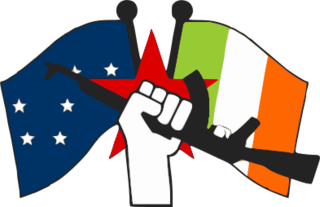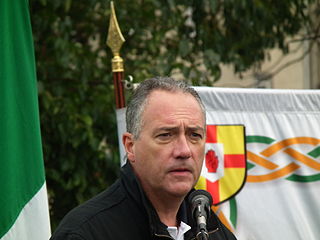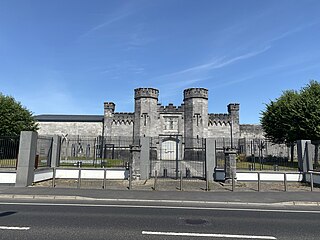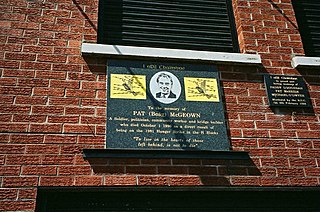
HM Prison Maze was a prison in Northern Ireland that was used to house paramilitary prisoners during the Troubles from August 1971 to September 2000. On 15 October 1974 Irish Republican internees burned 21 of the compounds used to house the internees thereby destroying much of Long Kesh.

The Irish National Liberation Army is an Irish republican socialist paramilitary group formed on 8 December 1974, during the 30-year period of conflict known as "the Troubles". The group seeks to remove Northern Ireland from the United Kingdom and create a socialist republic encompassing all of Ireland. With membership estimated at 80–100 at their peak, it is the paramilitary wing of the Irish Republican Socialist Party (IRSP).

The 1981 Irish hunger strike was the culmination of a five-year protest during the Troubles by Irish republican prisoners in Northern Ireland. The protest began as the blanket protest in 1976, when the British government withdrew Special Category Status for convicted paramilitary prisoners. In 1978, the dispute escalated into the dirty protest, where prisoners refused to leave their cells to wash and covered the walls of their cells with excrement. In 1980, seven prisoners participated in the first hunger strike, which ended after 53 days.

HM Prison Armagh, also known as Armagh Gaol, is a former prison in Armagh, Northern Ireland. The construction of the prison began in 1780 to a design of Thomas Cooley and it was extended in the style of Pentonville Prison in the 1840 and 1850s. For most of its working life Armagh Gaol was the primary women's prison in Ulster. Although the prison is often described as Armagh Women's Gaol, at various points in its history, various wings in the prison were used to hold male prisoners.

Tomás Séamus Cardinal Ó Fiaich, KGCHS was an Irish prelate of the Catholic Church. He served as the Catholic Primate of All Ireland and Archbishop of Armagh from 1977 until his death. He was created a Cardinal in 1979. Ó Fiaich was born in 1923 in Cullyhanna and raised in Camlough, County Armagh.

Séanna Walsh or Séanna Breathnach is a Sinn Féin member of Belfast City Council and a former volunteer in the Provisional Irish Republican Army (IRA).
The blanket protest was part of a five-year protest during the Troubles by Provisional Irish Republican Army (IRA) and Irish National Liberation Army (INLA) prisoners held in the Maze prison in Northern Ireland. The republican prisoners' status as political prisoners, known as Special Category Status, had begun to be phased out in 1976. Among other things, this meant that they would now be required to wear prison uniforms like ordinary convicts. The prisoners refused to accept the administrative designation of ordinary criminals, and refused to wear the prison uniform.

Mairéad Farrell was a member of the Provisional Irish Republican Army (IRA). She was shot and killed by the British Army in Gibraltar on 6 March 1988.

Portlaoise Prison is a maximum security prison in Portlaoise, County Laois, Ireland. Until 1929 it was called the Maryborough Gaol. It should not be confused with the Midlands Prison, which is a newer, medium security prison directly beside it; or with Dunamaise Arts Centre, which was the original Maryborough Gaol built c. 1789.
Kieran Nugent was an Irish volunteer in the Provisional Irish Republican Army (IRA) and best known for being the first IRA 'blanket man' in the Maze Prison in Northern Ireland. When sentenced to three years for hijacking a bus, Nugent refused to wear a prison uniform and said the prison guards would have to "...nail it to my back".
Seán McCaughey was an Irish Republican Army leader in the 1930s and 1940s and hunger striker.
In July 1972, William Whitelaw, the Conservative British government's Secretary of State for Northern Ireland, granted Special Category Status (SCS) to all prisoners serving sentences in Northern Ireland for Troubles-related offences. This had been one of the conditions set by the Provisional Irish Republican Army (IRA) when they negotiated a meeting with the government to discuss a truce.
Patrick Quinn was a volunteer with the 1st Battalion, South Armagh Brigade of the Provisional Irish Republican Army (IRA) who took part in the 1981 Irish hunger strike.

Brendan Hughes, also known as "The Dark", and "Darkie" was a leading Irish republican and former Officer Commanding (OC) of the Belfast Brigade of the Provisional Irish Republican Army (IRA). He was the leader of the 1980 Irish hunger strike.

Raymond McCartney is an Irish former Sinn Féin politician, and a former hunger striker and volunteer of the Provisional Irish Republican Army (IRA).
Laurence McKeown is an Irish author, playwright, screenwriter, and former volunteer in the Provisional Irish Republican Army (IRA) who took part in the 1981 Irish hunger strike.

Pat "Beag" McGeown was a volunteer in the Provisional Irish Republican Army (IRA) who took part in the 1981 Irish hunger strike.
Jackie "Teapot" McMullan is a former volunteer in the Provisional Irish Republican Army (IRA) who took part in the 1981 Irish hunger strike.

Hunger is a 2008 historical drama film about the 1981 Irish hunger strike. It was directed by Steve McQueen and starred Michael Fassbender, Liam Cunningham, and Liam McMahon.
The 1980–1981 Armagh Prison Dirty Protest occurred at the all-women Armagh Prison in Northern Ireland, where prisoners refused to bathe, use the lavatory, empty chamber pots, or clean their cells. This resulted in unsanitary conditions and increased abuse at the hands of the prison guards. The protest borrowed tactics previously used by male Irish republican prisoners in Long Kesh Prison, that had started in 1978.











